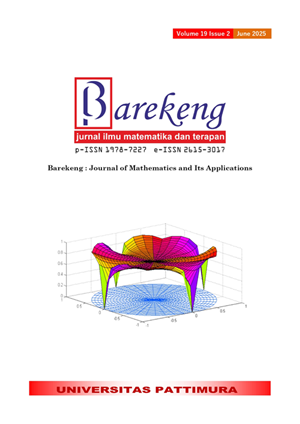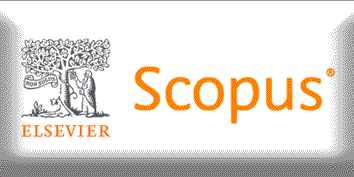COMPARISON BETWEEN BICLUSTERING AND CLUSTER-BIPLOT RESULTS OF REGENCIES/CITIES IN JAVA BASED ON PEOPLE’S WELFARE INDICATORS
Abstract
The success of a country's development can be known from the well-being of its people. Improving the welfare of the population is the main goal of the development activities carried out by the government. To ensure that development is effective and targeted, grouping is needed to understand the characteristics of the region. This study discusses the grouping of regencies/cities in Java Island based on the people's welfare indicators in 2022. The measured welfare is material well-being. Variables used in this study are the percentage of the poor population, GDP per capita at current prices, average length of schooling, expected length of schooling, percentage of per capita expenditure on food, open unemployment rate, population, population density, and life expectancy. There are two approaches used in grouping regencies/cities along with their variables. The first approach is to simultaneously group regencies/cities and their variables using Plaid Model biclustering. The second approach is to group regencies/cities using the Ward clustering method followed by the biplot method. This study aims to compare the results of these two approaches, namely the biclustering and cluster-biplot results, on data from 119 regencies/cities in Java Island in 2022 based on people's welfare indicators. Based on the results of this study, the number of groups from each approach is 2, with group 1 being more prosperous than group 2. Judging from the standard deviation values, the Plaid Model biclustering result groups have lower standard deviation values than the cluster-biplot result groups. Therefore, in general the first approach produces better groups as they are more homogeneous than the second approach.
Downloads
References
Badan Pusat Statistik, HASIL SENSUS PENDUDUK 2020, Jakarta: Badan Pusat Statistik, 2021. https://www.bps.go.id/id/pressrelease/2021/01/21/1854/hasil-sensus-penduduk-2020.html
A. F. N. Arif and N. Nurwati, "PENGARUH KONSENTRASI PENDUDUK INDONESIA DI PULAU JAWA TERHADAP KESEJAHTERAAN MASYARAKAT," Jurnal Ilmu Kesejahteraan Sosial “Humanitas” Fisip Unpas, vol. 4, no. 1, pp. 54-70, 2022. https://www.semanticscholar.org/paper/PENGARUH-KONSENTRASI-PENDUDUK-INDONESIA-DI-PULAU-Arif-Nurwati/c4d70585b832f16c08c1e0aa207edb2002c1dec0
R. A. Mulia and N. Saputra, "ANALISIS FAKTOR-FAKTOR YANG MEMPENGARUHI KESEJAHTERAAN MASYARAKAT KOTA PADANG," Jurnal El-Riyasah, vol. 11, no. 1, pp. 67-83, 2020. http://dx.doi.org/10.24014/jel.v11i1.10069
S. Yulianto and K. H. Hidayatullah, "ANALISIS KLASTER UNTUK PENGELOMPOKAN KABUPATEN/KOTA DI PROVINSI JAWA TENGAH BERDASARKAN INDIKATOR KESEJAHTERAAN RAKYAT," Jurnal Statistika Universitas Muhammadiyah Semarang, vol. 2, no. 1, pp. 56-63, 2014. https://doi.org/10.26714/jsunimus.2.1.2014.%25p
N. Dwitiyanti, N. Selvia and F. R. Andrari, "PENERAPAN FUZZY C-MEANS CLUSTER DALAM PENGELOMPOKAN PROVINSI INDONESIA MENURUT INDIKATOR KESEJAHTERAAN RAKYAT," Faktor Exacta, vol. 12, no. 3, pp. 201-209, 2019. http://dx.doi.org/10.30998/faktorexacta.v12i3.4526
Badan Pusat Statistik, STATISTIK INDONESIA 2023, Jakarta: Badan Pusat Statistik, 2023. https://archive.bps.go.id/publication/2023/02/28/18018f9896f09f03580a614b/statistik-indonesia-2023.html
Imasdiani, I. Purnamasari and F. D. T. Amijaya, "PERBANDINGAN HASIL ANALISIS CLUSTER DENGAN MENGGUNAKAN METODE AVERAGE LINKAGE DAN METODE WARD (STUDI KASUS: KEMISKINAN DI PROVINSI KALIMANTAN TIMUR TAHUN 2018," Jurnal Eksponensial, vol. 13, no. 1, pp. 9-18, 2022. https://jurnal.fmipa.unmul.ac.id/index.php/exponensial/article/view/875/356
H. A. e. a. Majd, "EVALUATION OF PLAID MODELS IN BICLUSTERING OF GENE EXPRESSION DATA," Hindawi Publishing Corporation, 2015. https://pubmed.ncbi.nlm.nih.gov/27051553/
T. Siswantining, A. E. Aminanto, D. Sarwinda and O. Swasti, "BICLUSTERING ANALYSIS USING PLAID MODEL ON GENE EXPRESSION DATA OF COLON CANCER," Austrian Journal of Statistics, vol. 50, pp. 101-114, 2021. https://ajs.or.at/index.php/ajs/article/view/1195
H. B. T. &. K. W. Turner, H. Turner, T. Bailey and W. Krzanowski, "IMPROVED BICLUSTERING OF MICROARRAY DATA DEMONSTRATED THROUGH SYSTEMATIC PERFORMANCE TESTS," Computational Statistics & Data Analysis, vol. 48, no. 2, pp. 235-254, 2005. https://doi.org/10.1016/j.csda.2004.02.003
J. F. Hair, W. C. Black, B. J. Babin and R. E. Anderson, MULTIVARIATE DATA ANALYSIS, 7th Edition, New York: Pearson Education, 2014.
N. Shrestha, "Factor Analysis as a Tool for Survey Analysis," AMERICAN JOURNAL OF APPLIED MATHEMATICS AND STATISTICS, vol. 9, no. 1, pp. 4-11, 2021. https://dx.doi.org/10.12691/ajams-9-1-2
R. A. Johnson and D. W. Wichern, APPLIED MULTIVARIATE STATISTICAL ANALYSIS, vol. 6, UK: Pearson London, 2014.
L. Kaufman and P. J. Rousseeuw, FINDING GROUPS IN DATA: AN INTRODUCTION TO CLUSTER ANALYSIS, vol. 344, John Wiley & Sons, 2009.
A. C. Rencher and W. F. Christensen, METHODS OF MULTIVARIATE ANALYSIS, 3rd Edition, New jersey: John Wiley & Sons, 2012.
I. T. Jolliffe, PRINCIPAL COMPONENT ANALYSIS, 2nd Edition, New York: Springer, 2010.
Copyright (c) 2025 Yekti Widyaningsih, Alfia Choirun Nisa

This work is licensed under a Creative Commons Attribution-ShareAlike 4.0 International License.
Authors who publish with this Journal agree to the following terms:
- Author retain copyright and grant the journal right of first publication with the work simultaneously licensed under a creative commons attribution license that allow others to share the work within an acknowledgement of the work’s authorship and initial publication of this journal.
- Authors are able to enter into separate, additional contractual arrangement for the non-exclusive distribution of the journal’s published version of the work (e.g. acknowledgement of its initial publication in this journal).
- Authors are permitted and encouraged to post their work online (e.g. in institutional repositories or on their websites) prior to and during the submission process, as it can lead to productive exchanges, as well as earlier and greater citation of published works.






1.gif)



